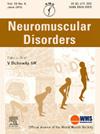Neurogenic arthrogryposis, hypotonia, dysmorphic features plus malformation of cortical development further expands the ARL6IP1 loss-of-function phenotype
IF 2.7
4区 医学
Q2 CLINICAL NEUROLOGY
引用次数: 0
Abstract
Biallelic variants in ARL6IP1 are associated with a rare, complicated form of progressive hereditary spastic paraplegia. Among the few cases reported thus far, two distinct phenotypic clusters with upper and lower motor neuron pathology and varying severities have emerged. Here, we describe a proband who presented with decreased fetal movements, intrauterine growth retardation, arthrogryposis multiplex congenita (AMC), dysmorphic features, weakness and hypotonia. Course was complicated by extubation failure and feeding problems at age 3 months. Muscle biopsy demonstrated neurogenic changes. Magnetic resonance imaging revealed thin corpus callosum and simplified gyri most notable at the insula with incomplete opercularization. The proband developed tongue fasciculations at 5 months, and passed away at 15 months of age. A homozygous deletion of exon 1–3 of ARL6IP1 was identified through exome sequencing. ARL6IP1-related phenotypes now include in utero involvement, neurogenic AMC, dysmorphic features, microcephaly and malformations of cortical development, in the absence of spastic paraplegia.
神经源性关节发育不良、肌张力低下、畸形特征和皮质发育畸形进一步扩展了 ARL6IP1 功能缺失表型
ARL6IP1的双等位基因变异与一种罕见的、复杂的进行性遗传性痉挛性截瘫有关。在迄今为止报道的少数病例中,出现了两种不同的表型集群,具有上下运动神经元病理和不同的严重程度。在这里,我们描述了一个先证谁提出胎动减少,宫内生长迟缓,多重先天性关节挛缩(AMC),畸形特征,虚弱和张力低下。3个月时拔管失败和喂养问题使病程复杂化。肌肉活检显示神经源性改变。磁共振成像显示胼胝体薄,脑回简化,最显著的是脑岛,不完全覆盖。先证者在5个月大时出现舌束,15个月大时去世。通过外显子组测序发现ARL6IP1外显子1-3纯合缺失。目前,在没有痉挛性截瘫的情况下,与arl6ip1相关的表型包括子宫受损伤、神经源性AMC、畸形特征、小头畸形和皮质发育畸形。
本文章由计算机程序翻译,如有差异,请以英文原文为准。
求助全文
约1分钟内获得全文
求助全文
来源期刊

Neuromuscular Disorders
医学-临床神经学
CiteScore
4.60
自引率
3.60%
发文量
543
审稿时长
53 days
期刊介绍:
This international, multidisciplinary journal covers all aspects of neuromuscular disorders in childhood and adult life (including the muscular dystrophies, spinal muscular atrophies, hereditary neuropathies, congenital myopathies, myasthenias, myotonic syndromes, metabolic myopathies and inflammatory myopathies).
The Editors welcome original articles from all areas of the field:
• Clinical aspects, such as new clinical entities, case studies of interest, treatment, management and rehabilitation (including biomechanics, orthotic design and surgery).
• Basic scientific studies of relevance to the clinical syndromes, including advances in the fields of molecular biology and genetics.
• Studies of animal models relevant to the human diseases.
The journal is aimed at a wide range of clinicians, pathologists, associated paramedical professionals and clinical and basic scientists with an interest in the study of neuromuscular disorders.
 求助内容:
求助内容: 应助结果提醒方式:
应助结果提醒方式:


